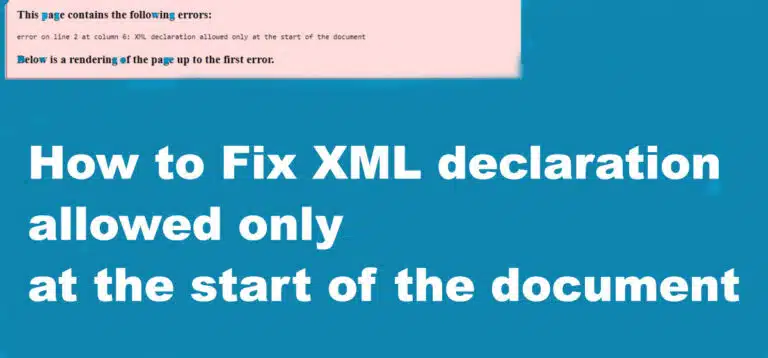The “XML Declaration Allowed Only At the Start of the Document” error is a common challenge faced by developers working with XML files. This issue occurs when an XML declaration, which typically includes information about the XML version and encoding, is found anywhere other than at the beginning of the document. In this essay, we will explore the causes of this error and provide solutions to resolve it effectively.
Understanding the Error
The XML declaration, often seen as <?xml version="1.0" encoding="UTF-8"?>, is designed to appear at the very beginning of an XML document. Its purpose is to inform parsers about the version of XML being used and the character encoding of the document. When this declaration is encountered anywhere other than at the start of the XML file, it results in the “XML Declaration Allowed Only At the Start of the Document” error.
Causes of the Error
Several factors can lead to this error, including:
- Incorrect Placement: The most common cause is when the XML declaration is mistakenly placed after some content in the XML file, instead of being the first line.
- Whitespace or Byte Order Mark (BOM): Sometimes, invisible characters such as whitespace or a Byte Order Mark (BOM) can precede the XML declaration, causing the parser to consider it as content rather than a declaration.
- Concatenation of XML Files: If multiple XML files are concatenated together, it’s essential to ensure that each file starts with its own XML declaration. Failure to do so can trigger this error.
Solutions to Resolve the Error
To resolve the “XML Declaration Allowed Only At the Start of the Document” error, follow these steps:
1. Check for Incorrect Placement:
- Open the XML file in a text editor.
- Ensure that the XML declaration
<?xml version="1.0" encoding="UTF-8"?>is the very first line of the document, with no content or whitespace preceding it.
2. Remove BOM or Whitespace:
- Use a text editor that can display invisible characters.
- Look for any invisible characters, such as a Byte Order Mark (BOM) or whitespace, before the XML declaration.
- Remove these characters so that the XML declaration is the first visible content in the file.
3. Validate XML Files:
- Use an XML validator or parser to check the validity of your XML files.
- Validators can identify issues such as incorrect placement of the XML declaration and provide suggestions for correction.
4. Separate Concatenated Files:
- If you are working with concatenated XML files, ensure that each file starts with its own XML declaration.
- Separate the files if necessary and ensure that each one begins correctly with
<?xml version="1.0" encoding="UTF-8"?>.
5. Encoding Declarations:
- If you are specifying an encoding in the XML declaration, ensure that it matches the actual encoding of the file.
- Common encodings include UTF-8 and UTF-16.
By following these steps, you can effectively resolve the “XML Declaration Allowed Only At the Start of the Document” error and ensure that your XML files are correctly formatted and parsed without issues.
In conclusion, the “XML Declaration Allowed Only At the Start of the Document” error can be resolved by checking for incorrect placement, removing invisible characters, validating XML files, separating concatenated files, and ensuring correct encoding declarations. By addressing these factors, developers can ensure that their XML documents adhere to the required standards, allowing for smooth parsing and processing.
